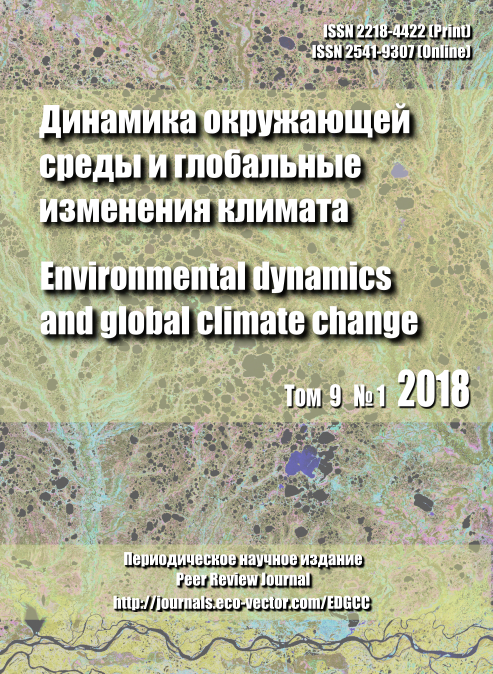Том 9, № 1 (2018)
- Год: 2018
- Выпуск опубликован: 04.06.2018
- Статей: 6
- URL: https://edgccjournal.org/EDGCC/issue/view/540
- Описание:
Экспериментальные работы
Дополнение к флоре мохообразных природного парка «Нумто» (Ханты-Мансийский автономный округ, Западная Сибирь)
Аннотация
В ходе геоботанического обследования растительности южной части природного парка «Нумто», расположенного в пределах подзоны северной тайги в центре Западно-Сибирской равнины, выявлено 140 вида мохообразных, в том числе 87 видов мхов и 53 вида печеночников, из которых 24 вида мхов и все печеночники являются новыми для территории природного парка. Новые находки в Западной Сибири двух редких видов сфагновых мхов – Sphagnum inexpectatum и S. mirum представляют большой научный интерес. Sphagnum inexpectatum впервые приводится для территориии Ханты-Мансийского автономного округа. Дополнены сведения об экологии и фитоценотической приуроченности 18 видов мхов, известных ранее в природном парке из одной точки или по немногим и единичным находкам. Приводится аннотированный список всех выявленных видов мохообразных.
 3-21
3-21


Климат заповедника «Малая Сосьва»: многолетние данные
Аннотация
В статье впервые представлен анализ метеорологических многолетних данных заповедника «Малая Сосьва» (Сосьвинское Приобье). Климат заповедника типично континентальный. Для него характерна суровая, снежная и продолжительная зима, короткое лето, поздние весенние и ранние осенние заморозки. Характерны резкие колебания температуры в течение всего года. Безморозный период в воздухе длится 78 дней. Годовое количество осадков - 544 мм. Снежный покров залегает в среднем 194 дня (более 6 месяцев). С 1981 года наблюдается повышение среднегодовой температуры воздуха от десятилетия к десятилетию приблизительно на 0,5˚С.
 22-45
22-45


Биотопическое распределение соболя на территории заповедника «Юганский»
Аннотация
Соболь (Martes zibellina L., 1758) – это уникальный вид отечественной фауны охотничьих животных. Изучение динамики численности и биотопического распределения соболя на территории заповедника «Юганский» ведется ежегодно с 1988 года. Выделено 4 типа местообитаний соболя. На основе материала, собранного в 1988-2015 гг., с помощью рассчитанного коэффициента предпочтения биотопа определена степень привлекательности для соболя различных типов местообитаний. Оптимальными для соболя являются лесные местообитания, среди которых по значимости резко выделяется темнохвойная тайга. Другие выделенные лесные местообитания (светлохвойная и мелколиственная тайга) обладают сходным набором экологических условий для жизни соболя, что определяет приблизительно равный уровень их привлекательности для популяции соболя. К пессимальным для соболя местообитаниям относятся верховые болота, для которых характерны самые низкие значения коэффициента предпочтения биотопа.
 46-52
46-52


Растительность и продуктивность болотных экосистем заповедника «Юганский»
Аннотация
В течение последних четырех лет проводятся биогеоценологические исследования на территории заповедника «Юганский», расположенного в средней тайге, в наиболее заболоченной подзоне тайги Западной Сибири. Дана оценка продуктивности растительности основных болотных экосистем олиготрофных и мезотрофных болот заповедника, которые занимают 30 - 35% территории. Показано, что запасы фитомассы изменяются от 1200 до 3820 г/м2 и составляют от 7 до 36 % от общих запасов растительного вещества. Древесный ярус может увеличивать запасы фитомассы на ряме на 60%, на гряде ГМК на 40%, на кочках озеркового комплекса на 10%. Продукция в экосистемах гряд и рямов изменяется от 700 до 1000 г/м2 в год, мочажин от 650 до 1700 г/м2 в год, наиболее продуктивными оказались более обводненные экосистемы озерковых комплексов и мезотрофные топи.
 53-61
53-61


Редкие виды пресноводных моллюсков бассейна Большого Югана (Среднее Приобье) в сборах 2016 года
Аннотация
По материалам сборов 2016 г. приведены первые сведения о редких видах пресноводных моллюсков бассейна р. Большой Юган. Отмечено отсутствие сведений в региональных Красных книгах и обоснована актуальность изучения редких видов моллюсков. Обсуждаются аспекты редкости и сложности изучения редких видов пресноводных моллюсков, связанные с существованием различных таксономических подходов и недостаточной изученностью фауны и экологии. Приведены краткий литературный обзор изучения редких видов в районе исследований и Западной Сибири, результаты собственных исследований и аннотированный список пресноводных моллюсков бассейна р. Большой Юган в сборах 2016 г. Показана значительная доля редких видов в малакофауне бассейна. Сформулирован вывод о необходимости дальнейших исследований, обозначены их приоритеты.
 62-71
62-71


Редкие растения и растительные сообщества болот богатого грунтового питания заповедника «Малая Сосьва» (Западная Сибирь)
Аннотация
Проведено геоботаническое обследование низинных и переходных болот левобережных террас р. Ем-Еган, правого притока р. Малая Сосьва в южной части заповедника «Малая Сосьва» (61.79° – 62.05°N, 64.06° – 64.55°E). Выявлено 179 видов, в том числе 84 вида высших сосудистых растений, 69 видов мхов и 26 видов печеночников. Из них в Красную книгу Ханты-Мансийского автономного округа – Югры и приложение к ней входят 11 видов, в том числе 9 видов высших сосудистых растений и 2 вида мхов: Baeothryon alpinum, Cardamine nymanii, Dactylorhiza traunsteineri, D. incarnata, Hammarbya paludosa, Huperzia selago, Saxifraga hirculus, Thelypteris palustris, Triglochin palustre, Meesia triquetra, Paludella squarrosa. Еще 3 вида – Corallorrhiza trifida, Calliergon richardsonii, Meesia uliginosa вошли в Приложение к Красной книге, как виды, состояние которых в природной среде требует особого внимания. Кроме того, в растительном покрове болот встречены такие редкие в равнинной части территории автономного округа виды, как Eriophorum brachyantherum, Stellaria crassifolia, Bistorta major, а также редкие виды мхов – Bryum bimum, Calliergonella cuspidata, Campylium pretense, Hamatocaulis vernicosus, Scorpidium cossonii, Tomentypnum nitens.
На основе метода флористической классификации Ж. Браун-Бланке в растительном покрове низинных и переходных болот богатого грунтового питания выделено 8 ассоциаций, 6 субассоциаций и 3 сообщества из 5 союзов, 3 порядков и 3 классов растительности. Принадлежность еще одного сообщества горцево-сфагнового ерника с редкостойным ярусом ели (Picea obovata) к классу и порядку не установлена. Наиболее высокое фитоценотическое разнообразие и наибольшая встречаемость редких и охраняемых видов отмечена в сообществах порядка Sphagno warnstorfii–Tomentypneetalia. Установлена фитоценотическая приуроченность и частота встречаемости редких видов в разных типах растительных сообществ.
 72-92
72-92











